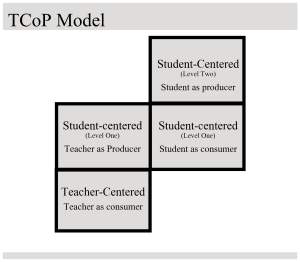Choosing your OER Tools: A Tool Look Book
4.2 Choosing and Using Your Tools
Theresa Huff
Whether you are designing a course or an OER, the tools and technologies you choose should be aligned with and support your learners toward achieving your learning objectives (Quality Matters Specific Review Standard 6.1; Mayer & Fiorella, 2023). This chapter acts as a thoughtful look book of tools you might consider using.
The first part of the chapter focuses on how to choose your tools by offering a model for thinking through who will use the tool and how you plan to use the tool. Next, we’ll look again at our tools through the lens of Accessibility and Universal Design for Learning (UDL), Sustainability, and Engagement. The chapter then offers a look book of tools you can interact and play with to see if and how they can support your learning objectives. Finally, the chapter concludes with a reflective practice on the tools you chose and how they meet the criteria of accessibility, engagement, and sustainability. Your reflection will eventually be a deliverable at the end of Year 2.
The TCoP Model for Using Tools
As you are considering how to use these tools, consider also who might use them. While we typically think about the instructor as the one using the tools, many of these tools could be used by the student, too. The Technology Consumer or Producer (TCoP model) (Curry et al., 2022) is a proactive, helpful tool as you are planning your instruction and potential Open Pedagogy options.

Consider that technology and tools can be used in several ways:
Teacher as Consumer
Consider what technologies and tools you use to watch, listen to, or read content.
Examples: YouTube, podcasts, digital books, blogs, social media, etc.
Teacher as Producer
Consider what technologies and tools you use to produce instruction. What tools will you use to produce your content or to produce formative assessment for your students? Here are some ideas:
Create and present your OER content in
-
-
-
- digital text
- a video
- a podcast
- an H5P for Content
- an Infographic
-
-
Create formative assessments in your OER with
-
-
-
- H5P interactives
- H5P assessment tools
- Hypothes.is assignments
- Simulations
- Online labs
-
-
Student as Consumer
Consider what technologies and tools students use in an OER. What tools will your students use to get the content and practice they need? The same tools listed above under Instructor as producer can be consumed by a student, but not everything has to be created or produced by the instructor. You can use existing versions of all of those tools listed, too. Ah, the beauty of OER!
Student as Producer
Consider what technologies and tools students could use to produce learning objects or assignments that would fulfill learning objectives. With the variety of open-source tools available, you can design authentic assessments that help students reach the higher levels of Bloom’s taxonomy (create). Creation assignments work particularly well for summative assessments. Here are some ideas for students as producers:
-
-
- videos
- podcasts
- a chapter of your OER
- a blog post
- a series of social media posts
- interactive H5P presentations
- a series of H5P practice quizzes that could be used in your OER
-
As you continue through this chapter, allow yourself to think outside the box about how technology and tools might be used and who might use them, while remaining thoughtful about the tool itself.
Resources
Curry, J. H., Jackson, S. R., & Morin, H. (2022). It’s Not Just the HOW, But Also the WHO: The TCoP Model of Technology Integration. TechTrends, 66(6), 980-987.
Mayer, R. E. (Ed.). (2005). The Cambridge handbook of multimedia learning. Cambridge university press.
Standards from the Quality Matters Higher Education Rubric, Seventh Edition. Quality Matters. Retrieved from Specific Review Standards from the QM Higher Education Rubric, Seventh Edition
